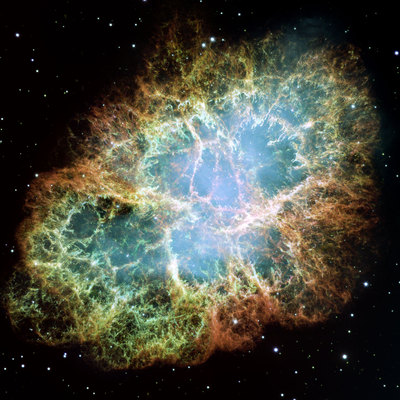2006 AMANDA Point Source Analysis
Event Selection
Methodology, Sensitivity & Discovery Potential
Unblinding Proposal
Results
Questions and Answers
 |
| NASA/ESA Hubble |
Event Selection
Cuts are identical to those used in 2005.
Cut Expressions
| Likelihood ratio | Jkchi[Bayesian64]-Jkchi[Pandel] > 33 - 33.3*Theta(0.15-x)*(0.15-x) + 5*Theta(x-0.15)*(x-0.15) |
| Paraboloid error | 180/PI * sqrt(err1*err2) < 4.4 - 3.4*Theta(0.35-x)*(0.35-x) - 2.333*Theta(x-0.35)*(x-0.35) |
| Smoothness | abs(S_phit) < 0.42 - 0.1*Theta(x-0.25)(x-0.25) |
| Direct length | Ldirb[Pandel] > 38 + 96*Theta(x-0.7)*(x-0.7) |
| Flare variables | TOT_short + B10 + nB10 < 10 |
The Final Event Sample
Application of the cuts on time-scrambled data results in 5433 events above 80 degrees zenith. A significant portion of the events are downgoing muons near 80 degrees. Above 100 degrees, 924 data events remain. 891 atmospheric neutrino events are expected using the Lipari flux.
Muon neutrino effective area agrees with previous analyses. Error bars indicate the statistical error in effective area from MC.

Normalization
The usual procedure of tightening cuts until the ratio of data to atmospheric MC becomes constant is applied for zenith > 100, obtaining a normalization factor of 0.945 (Lipari). The amount of background present in the final sample above 100 degrees is ~10% (6.5% in 2005). The data/MC normalization factor is somewhat higher than in 2005 (0.82 in 2005). One sigma is 3%-4% of the normalization factor, so the number of events recorded in 2005 and 2006 are not incompatible given the same parent flux.
The final normalization is computed identically to 2005, comparing the ratio of data to atmospheric simulation, using the average event rate of Honda and Bartol atmospheric fluxes. This results in a final normalization factor of 1.04.
Elimination of Flasher Events
A final check is performed to verify a rogue flasher run is not the cause of the small apparent atmospheric neutrino rate increase seen in 2006. GPSDay and azimuth distributions of events with zenith > 100o do not indicate a significant excess of events from any direction or time. |  |
Distribution of Cut Parameters for Final Sample(Zenith > 100)
 |
 |
 |
 |

Distribution of Flare Parameter for Final Sample, Before Flare Cut

Distribution of All Flare Parameters After FInal Cut
 |  |  |
 |  |  |
 |  |  |